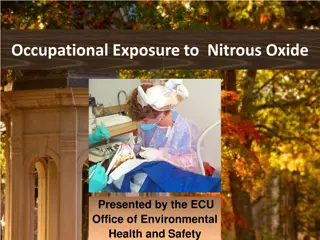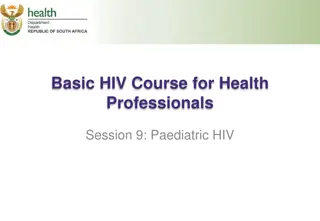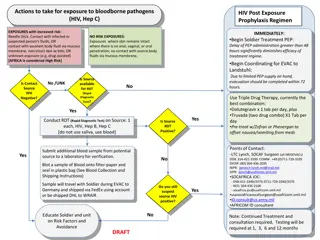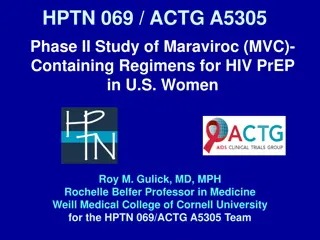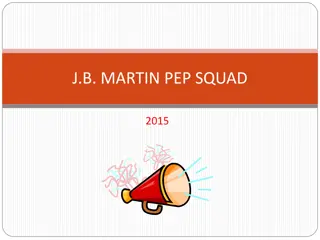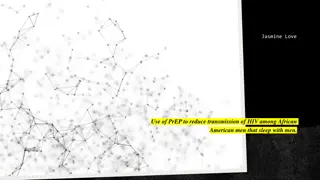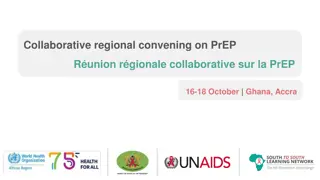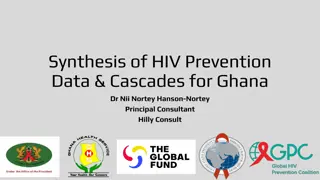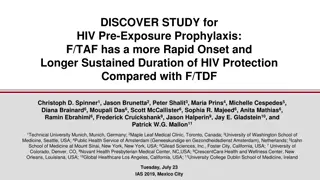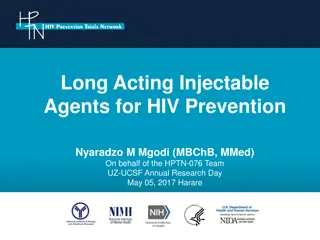Understanding HIV Post-Exposure Prophylaxis (PEP) and Prevention
HIV Post-Exposure Prophylaxis (PEP) is a crucial emergency medical response for individuals exposed to HIV, aiming to prevent infection. It involves a regimen of medications, tests, and counseling services initiated within 72 hours of exposure. HIV transmission occurs through body fluids like blood, semen, and vaginal fluids, with common transmission routes being unprotected sexual contact and contaminated needles. Prevention strategies include PrEP for high-risk individuals and adherence to standard precautions. HIV is not transmitted through casual contact like kissing or sharing clothes.
Download Presentation

Please find below an Image/Link to download the presentation.
The content on the website is provided AS IS for your information and personal use only. It may not be sold, licensed, or shared on other websites without obtaining consent from the author. Download presentation by click this link. If you encounter any issues during the download, it is possible that the publisher has removed the file from their server.
E N D
Presentation Transcript
UN HIV PEP BRIEFING HIV Post-Exposure Prophylaxis (PEP) Division of Healthcare Management and Occupational Safety and Health (DHMOSH) Public Health Unit 0
What is HIV Post-Exposure Prophylaxis? The main objective of PEP is prevention of HIV infection It is an emergency medical response for an individual exposed to HIV Consists of medications, laboratory tests and counseling services to the exposed Must be initiated as soon as possible from time of possible HIV exposure and can be given within 72 hours after exposure HIV PEP Antiretroviral Medications must be taken daily for 28 days. 1
How is HIV Transmitted Body fluids transmitting HIV? Blood Semen Vaginal fluids Breast milk Opportunities for HIV to enter the body? Cuts, sores, Open wounds Vaginal lining Mucous membrane (e.g. eyes, mouth) Rectum Urethra Saliva, Vomits, Sweat, Tears, Urine when contaminated with blood can transmit HIV infection. 2
Most common ways through which HIV is transmitted During sexual contact Unprotected anal, vaginal sex with infected partner Oral sex (Lower risk) Transfusion of untested HIV-infected blood or blood products Accidental contact with contaminated blood, other body fluids From mother to child during pregnancy, child birth, breast feeding Contaminated needles & syringes injury from sharing needles 3
HIV is NOT transmitted by Kissing Sharing clothes Coughing/sneezing Eating together Shaking hands Mosquito bites Sharing toilets Sharing combs Sharing swimming pool Living together in a family Caring for infected persons 4
Preventing HIV Infection Pre-exposure prevention - Condoms - Standards Precautions Pre-Exposure Prophylaxis (PrEP) An HIV-negative person at high risk of exposure takes a pill a day of anti-HIV medication to prevent HIV infection in case of accidental exposure. PrEP is currently recommended for people who are in constant exposure to HIV infection by virtue of their relationship and/or occupation 5
Preventing HIV Infection Post-exposure Prevention Emergency HIV Post-Exposure Prophylaxis (PEP) First aid care Aside from sexual assault where forensic information might be required , immediate first aid including cleaning with soap and water or water only for several minutes is an important way to prevent infection 6
HIV Post-Exposure Prophylaxis (PEP) During sexual contact HIV Post-Exposure Prophylaxis (HIV PEP) - a set of services provided to prevent HIV infection following potential exposure to the virus. Services include first aid, counselling, HIV exposure risk assessment, HIV testing (with informed consent), a course of anti-HIV medication, with appropriate support and follow up. Adherence to a full 28-day course of anti-retroviral (ARV) medicines is important in order to reduce risk of infection acquisition. 7
Why the UN Provides HIV PEP 1. Ideally, HIV PEP should be available from any emergency medical service anywhere in the world. 2. This is true already in many places, but not yet in all. 3. Therefore, the UN provides HIV PEP to field offices As a responsible employer, because personnel can be at risk while working for the UN, especially in locations where HIV PEP is not available from local medical services. To standardize access to HIV PEP for UN personnel as different countries still apply various degrees of restriction to access to HIV PEP. 8
UN HIV PEP Kit An emergency UN HIV PEP Kit that provides a full 28-day HIV Post-Exposure Prophylaxis to UN personnel and their recognized dependants who may have been accidentally exposed to HIV. 9
UN HIV PEP Kit Contents 1. Anti-retroviral drugs: A full 28-day anti-retroviral HIV medication A combination tablet (Three Anti-retroviral HIV drugs in one tablet). ONE tablet is taken each for 28 days 2. Pregnancy test strip To identify if an exposed woman of childbearing age was already pregnant before potential exposure to the virus 3. Emergency oral contraception ( morning-after pill) Tablets of Levonorgestrel to prevent unwanted pregnancy. 4. Guidance booklet on the use of PEP Kits Guidance for the PEP Kit custodian, Patient, and attending Physician 10
Who is Not Eligible for HIV PEP ? The kits are not available for individuals who are/may be; For medical reasons, PEP kits are not available to personnel or recognized dependents who are already living with HIV. Individuals with severe liver of kidney diseases, or Individuals with history of anaphylaxis to any of the medication in the kit. 11
Why have the Kits in duty stations? The kits are provided so that the medication can be initiated as soon as feasible after possible HIV exposure and within 72 hours after possible exposure, and the necessary arrangements can be made for the evacuation of the patient to a location with adequate medical facilities, in order to continue the PEP Treatment 12
Is the Patients Consent required? YES BEFORE the attending physician initiates the PEP Treatment, he /she must first obtain the consent of the patient. CONFIDENTIALITY: Yes, all information and documentation regarding HIV PEP and sexual assault incident or occupational accidents must be treated with the strictest confidentiality. 13
Who is Eligible for UN HIV PEP Kit UN HIV PEP Kits are available to all individuals with a United Nations agency contract and their spouses and dependent children who may have been accidentally exposed to HIV, regardless of means of exposure. The relevant fundamental principle is that UN Security Management System personnel and their eligible dependents should have rapid and reliable access to PEP treatment, if required, as a means of managing personal and organizational risks. Post-Exposure Prophylaxis (PEP) Kits are available for the immediate treatment of UN Security Management System personnel (including long-term, short-term, SSA and others) and eligible dependents, who may have been exposed to HIV infection, regardless of means of exposure. 14
Procurement and distribution of PEP kits The selection and validation of the PEP kit contents are coordinated by DHMOSH with UN Medical Directors and other stakeholders. DHMOSH coordinates the procurement and distribution of PEP kits to duty stations with UNDSS and countries UN senior management team/Office of the Designated Official (DO) Some UN Peacekeeping Missions are currently doing direct procurement of their PEP Kits. 15
Country-Level PEP Kit Management Structure Designated Official Security Management Team Country PEP Kit Manager UN Location A UN Location B UN Location C UN Location D UN Location E UN Location F Custodian Alternate Custodian Alternate Custodian Alternate Custodian Alternate Custodian Alternate Custodian Alternate Alternate Custodian are required to ensure availability of a custodian at all time and to ensure continuous access to the HIV PEP 16
Role of Country Management In all countries receiving PEP kits, must ensure that the PEP Annex has been included in the country security plans all their country. Must ensure the PEP kits manager has been designated for the country The UN Designated Official and UN Security Management team will coordinate the selection of Country PEP manager 17
Role of Country PEP Management Responsible for all PEP kits sent to the duty stations and the country. Send a confirmation of receipt of PEP kits for the country to: dos-dhmosh-hiv@un.org Ensure that PEP kit custodian have been designated for all UN locations/duty stations in their respective country and provided them with PEP kits. Ensure that all selected PEP kits custodians have designated alternates or deputies. Ensure that all PEP kits custodians in the country have undergone training on their roles and responsibilities. 18
Role of Country PEP Management Ensure that PEP kits in all UN locations are safety kept under tamper-proof and hygienic conditions, and follow manufacturers storage recommendations. Ensure that expired PEP kits are collected and safely destroyed (or returned to WHO Medical Services, Geneva, for destruction). Ensure that PEP kit custodians contact list has been shared with all UN personnel in the country through most commonly used communications channels- emails. Security bulletin etc. Ensure that staffs are provided with PEP kit information through UN HIV orientation and other staff briefings. 19
Role of PEP Kit Custodian Provide PEP services to all clients based on the PEP guidelines and country management protocol. For every PEP kit used, must complete a MANDATORY report form and send to UN Division of Healthcare Management and Occupational Safety and Health New York at dos-dhmosh-hiv@un.org Must send request for replacement of used PEP kit through their country manager to dos-dhmosh-hiv@un.org immediately after usage. Provide PEP kit users the option to receive follow-up support from UN Division of Healthcare Management and Occupational Safety and Health New York 20
Country-Level PEP Kit Management Structure Exposure to HIV Confirmed Custodian Custodian Conduct Administrative Eligibility Custodian Custodian Conduct Full HIV PEP Eligibility Custodian Inform Client on Compliance and Adherence to Prescribed Treatment Healthcare Provider Custodian Accompany Client to Healthcare Provider who Administer The Kit Healthcare Provider 21
Key Steps in Releasing a PEP Kit 1. If necessary, offer basic emotional support and reassure the person. 2. PEP kit Custodian Conduct administrative eligibility evaluation to determine if the individual qualifies for a UN HIV PEP Kit usage. 3. Full PEP treatment eligibility evaluation is only done by a health care provider. 4. Custodian and Healthcare provider must mention to the individual what PEP treatment means and that it is important to go through the full treatment. 5. Contact the UN Physician in the country or the health care provider listed in the PEP Annex to the Country Security Plan informing him/her of the case and making arrangements for PEP treatment. 6. Accompany the individual to the health care provider and hand over the kit to the provider. 7. Ensure safe and proper storage of PEP Kit. 8. Maintain Proper inventory and record of the Kits, ensuring uninterrupted supply and availability. 22
Key Steps in Releasing a PEP Kit (Contd.) 9. Evaluation of the administrative right of the person to receive the UN PEP Kit 10. Release a kit to a Health Care Provider after ensuring administrative eligibility of the individual. 11. Ensure confidentiality of all related information and documentation. 12. Ensure 24/7 accessibility of Kits. 13. Ensure that where a health care provider cannot be reached within 72 hours of exposure, that they advise exposed persons to call a center of excellence on HIV, as listed in the PEP Annex to the Country Security Plan. 14. A medical provider at the center of excellence can perform a risk assessment over the telephone. 15. HIV PEP Usage reporting is mandatory, custodian must report using the provided reporting form to DHMOSH. 23
Care and Storage of PEP Kits PEP Kits contain medication that should be carefully stored according to manufacturer s specifications. Locked containers to avoid misuse, theft or vandalism. Temperatures below 30oC. No refrigeration is required though. Dry and protected from light, humidity and excessive heat. All expired medication and commodities in the kit must be disposed by following the local health authorities guidance on medical consumable disposal, or Where this is not available, all expired kits should be mailed to World Health Organization as indicated in the HIV PEP Guidance document for disposal 24
PEP Kit Record Keeping Keep proper inventory of kits under custody Record and monitor expiry dates. Promptly record and report usage of every Kit Order replenishment of a used Kit. Promptly record new stock when received. All done in consultation with Country PEP Kit Manager 25
Resource and Contacts For more information on HIV/AIDS and staff wellbeing: https://hr.un.org/page/health-and-wellbeing For more information on HIV/AIDS: dos-dhmosh-hiv@un.org For further information and enquiries contact Division of Healthcare Management and Occupational Safety and Health: dos-dhmosh-public-health@un.org 26





